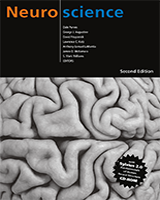By agreement with the publisher, this book is accessible by the search feature, but cannot be browsed.
NCBI Bookshelf. A service of the National Library of Medicine, National Institutes of Health.
Purves D, Augustine GJ, Fitzpatrick D, et al., editors. Neuroscience. 2nd edition. Sunderland (MA): Sinauer Associates; 2001.

Neuroscience. 2nd edition.
Show detailsThe relatively unspecialized nerve cell endings that initiate the sensation of pain are called nociceptors (noci- is derived from the Latin for “hurt”) (see Figure 9.2). Like other cutaneous and subcutaneous receptors, they transduce a variety of stimuli into receptor potentials, which in turn trigger afferent action potentials. Moreover, nociceptors, like other somatic sensory receptors, arise from cell bodies in dorsal root ganglia (or in the trigeminal ganglion) that send one axonal process to the periphery and the other into the spinal cord or brainstem (see Figure 9.1).
Because peripheral nociceptive axons terminate in unspecialized “free endings,” it is conventional to categorize nociceptors according to the properties of the axons associated with them (see Table 9.1). As described in the previous chapter, the somatic sensory receptors responsible for the perception of innocuous mechanical stimuli are associated with myelinated axons that have relatively rapid conduction velocities. The axons associated with nociceptors, in contrast, conduct relatively slowly, being only lightly myelinated or, more commonly, unmyelinated. Accordingly, axons conveying information about pain fall into either the Aδ group of myelinated axons, which conduct at about 20 m/s, or into the C fiber group of unmyelinated axons, which conduct at velocities generally less than 2 m/s. Thus, even though the conduction of all nociceptive information is relatively slow, there are fast and slow pain pathways.
In general, the faster-conducting Aδ nociceptors respond either to dangerously intense mechanical or to mechanothermal stimuli, and have receptive fields that consist of clusters of sensitive spots. Other unmyelinated nociceptors tend to respond to thermal, mechanical, and chemical stimuli, and are therefore said to be polymodal. In short, there are three major classes of nociceptors in the skin: Aδ mechanosensitive nociceptors, Aδ mechanothermal nociceptors, and polymodal nociceptors, the latter being specifically associated with C fibers. The receptive fields of all pain-sensitive neurons are relatively large, particularly at the level of the thalamus and cortex, presumably because the detection of pain is more important than its precise localization.
Studies carried out in both humans and experimental animals demonstrated some time ago that the rapidly conducting axons that subserve somatic sensory sensation are not involved in the transmission of pain. A typical experiment of this sort is illustrated in Figure 10.1. The peripheral axons responsive to nonpainful mechanical or thermal stimuli do not discharge at a greater rate when painful stimuli are delivered to the same region of the skin surface. The nociceptive axons, on the other hand, begin to discharge only when the strength of the stimulus (a thermal one in the example in Figure 10.1) reaches high levels; at this same stimulus intensity, other thermoreceptors discharge at a rate no different from the maximum rate already achieved within the nonpainful temperature range, indicating that there are both nociceptive and nonnociceptive thermoreceptors. Equally important, direct stimulation of the large-diameter somatic sensory afferents at any frequency in humans does not produce sensations that are described as painful. In contrast, the smaller-diameter, more slowly conducting Aδ and C fibers are active when painful stimuli are delivered; and when stimulated electrically in human subjects, they produce pain.

Figure 10.1
Experimental demonstration that nociception involves specialized neurons, not simply greater discharge of the neurons that respond to normal stimulus intensities. (A) Arrangement for transcutaneous nerve recording. (B) In the painful stimulus range, the (more...)
- Nociceptors - NeuroscienceNociceptors - Neuroscience
Your browsing activity is empty.
Activity recording is turned off.
See more...